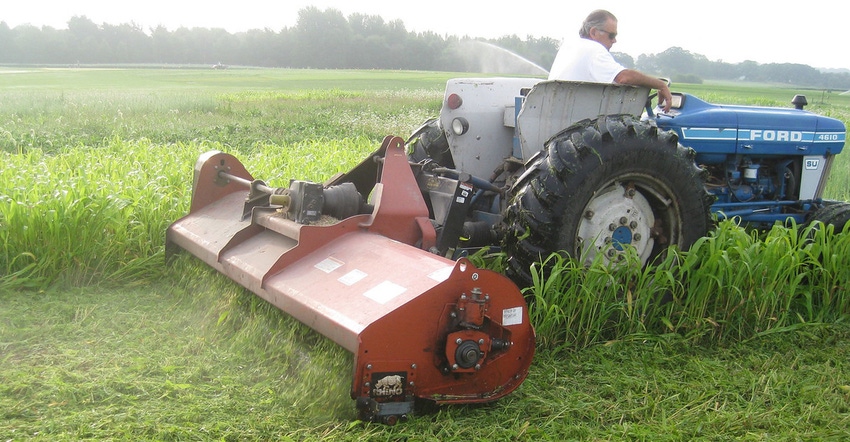July 15, 2019

Grain and livestock farmers can benefit from a recent rule change by USDA, which lets farmers who planted cover crops on prevented plant acres harvest those fields beginning Sept. 1. With the change, farmers can hay, graze or chop those fields, and USDA also has determined that silage, haylage and baleage should be treated the same as haying and grazing for this year.
The adjustment allows farmers to harvest cover crops on prevented plant acres two months earlier than most years, which will be beneficial in a year when both grain and forage crops are limited.
Brian Lang, Iowa State University Extension agronomist, notes that in most years farmers aren’t allowed to harvest their prevented planting cover crops until Nov. 1, which greatly limits choices of what crops would provide a quality, harvestable forage product at that time. “Before, we were trying to guess when we should plant something that would be in good condition for harvest after Nov. 1, but now we have incredible flexibility, with more time for optimal harvest of a given forage,” he says.
Grazing, haying cover crops
By the second week in July, Iowa farmers are most likely done planting warm-season cover crops, but they can still plant cool-season species — like oats for hay, haylage or grazing, and oat-brassicas for grazing — and expect a decent return if they’re planted by August. Farmers looking to add hay or pastureland for the next few years could also consider an August planting of alfalfa or other desirable perennial forages.
ISU beef specialists published the article Alternative Annual Forages, IBC 136, in May, which helps farmers compare planting and maturity dates for various species of forages, including their nutritional value.
Grain farmers with no livestock can still realize the conservation benefits of a cover crop. And if they have a neighbor with livestock, or an auction market nearby, they may be able to sell harvested forages. “It’s not a guaranteed money maker, but a grain farmer may have a neighbor who has the equipment to harvest it out of the field,” Lang says.
Increase forage supply
Erika Lundy, ISU Extension beef specialist, says the earlier harvest date will make a difference for Iowa cattle producers who are struggling in a year of limited forages. “This really increases the chances the cover crop will still be growing and vegetative at harvest, which will aid in higher feed quality of the cover crop,” she says.
Feed costs make up the largest expense for the cow herd, so any opportunity to extend the grazing season decreases this large production expense. Harvesting the cover crop forage will also likely be at a lower cost than purchasing outside forage sources for many producers. However, Lang and Lundy both advise that each operation is unique, and the benefits of using a cover crop as a forage can vary greatly by farm location and type of crop grown.
It’s also important that producers consider whether nitrogen had been applied to the fields where cover crops were later planted, at what level, and whether there is a nitrate issue. Prior herbicide use should also be considered to ensure cover crops can be legally and safely grazed or harvested.
The nutritional value of cover crops varies greatly by species and maturity at harvest and tends to be fairly different from typical hay sources producers are used to dealing with. Thus, Lundy says producers should spend the $20 to $30 it takes to submit a feed sample to determine the nutrient quality of the feedstuff and how to best use the feed to meet cattle requirements while managing feed costs.
Source: ISU, which is responsible for the information provided and is wholly owned by the source. Informa Business Media and subsidiaries aren’t responsible for any content in this information asset.
You May Also Like




